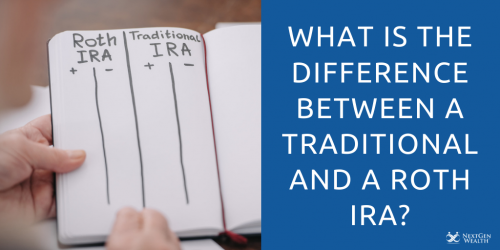What is the Difference Between a Traditional and a Roth IRA?
If you want to save money for retirement, you need to start doing it right now, no matter how old (or young) you are. While there are multiple methods for building a nest egg, one of the most reliable is contributing to an individual retirement account (IRA). 
There are two primary types of IRAs available - traditional and Roth. Both options have benefits and downsides, so it’s crucial to understand the differences between them. Here is what you need to know.
A Brief History of IRAs
For a long time, if you wanted to retire, you had to get a job that came with a pension or similar benefits. While you could save money in a bank account, it wouldn’t grow enough to build into something substantial.
As pensions and employer retirement benefits became less commonplace, workers needed some way to put funds away for their golden years. The Employment Retirement Income Security Act of 1974 created the individual retirement account. The act's goal was to provide oversight on employer-sponsored plans, and the IRA was a side effect.
The notable element of an IRA is that it belongs to an individual, not a company. So, workers can add money to it regardless of where they are employed, and they don’t risk losing benefits because of layoffs or switching jobs.
In 1981, the government passed the Economic Recovery Tax Act, which raised the contribution limit for IRAs and made them more popular with workers. In 1986, Congress reduced the impact of IRAs, making them less viable for retirement savings.
In 1997, the Taxpayer Relief Act introduced the Roth IRA, which was named after the senator who championed the bill, William V. Roth Jr. While many of the rules were similar, the primary difference between Roth and “traditional” IRAs is that contributions are made “after-tax.” This means that any growth is distributed tax-free when withdrawn as long as certain criteria are met.
Over the years since 1997, the contribution limits and taxation of IRAs have changed. The recent Tax Cuts and Jobs Act of 2017 made further adjustments, which we’ll discuss later.
Breaking it Down: How Traditional and Roth IRAs Differ
There are several components to pay attention to with an IRA.
- First, you have to consider how your funds are taxed and when
- Second, you need to know how much you can contribute to each plan
- Finally, there are rules regarding how you can withdraw funds from your account
Here is a breakdown of each section and how it differs between IRAs.
Taxes
When contributing to a traditional IRA, all of the money you put into the account is considered “pre-tax.” The purpose of this designation is so that you don’t have to pay taxes on those funds. Instead, you get to deduct them from your total income. Doing this can help with your overall tax burden for the year.
For example, let’s say that you contribute the max of $6,000 to a traditional IRA (2020). You get to deduct that from your income, which might put you in a lower tax bracket. Currently, in 2020, the brackets (for non-married individuals) are as follows:
- 10% Tax - $0 to $9,700
- 12% Tax - $9,701 to $39,475
- 22% Tax - $39,476 to $84,200
- 24% Tax - $84,201 to $160,725
- 32% Tax - $160,726 to $204,100
- 35% Tax - $204,101 to $510,300
- 37% Tax - $510,301 or Higher
Using this chart, let’s say that you made just over $84,000 during the year. Since you are close to getting into the next highest tax bracket, you can deduct the full $6,000 from your income, which will give you a much better buffer from moving into a higher tax bracket. Similarly, if your earnings for the year were slightly higher than in previous ones, you can claim the deduction so that your tax bill is the same.
Once the funds are in your account, the money can be invested and will grow tax-free. This doesn’t mean that you never have to pay taxes on it, but that you don’t have to pay anything until you withdraw the money. For example, if you have $50,000 and it accumulates another $5,000 in interest, you don’t have to pay anything on that.
You will, however, have to pay taxes when you withdraw money from your traditional IRA. Fortunately, if you wait until retirement (after 59.5), you can save a bundle overall. Assuming that your annual income is lower than when you were employed, your tax bill can be substantially reduced.
For example, let’s say that you were earning $100,000 annually, which would put you into the 24% tax bracket. However, once you retire, you might be making less than $40,000 annually, which will save you up to half of your potential tax bill.
With Roth IRAs, the tax implications are reversed. Instead of being able to deduct contributions from your income, your money is put into the account “after-tax.” The primary benefit here is that your money grows tax-free and comes out tax-free, although there is a small catch.
Any money you contribute to the account has already been taxed, so you can take it out whenever you like. However, because IRAs are investment accounts and can earn dividends, capital gains, and interest, you might have to pay taxes on those. To avoid any additional costs, you have to be at least 59.5 and have owned the account for five years or more.
In some cases, you can withdraw capital gains from a Roth tax-free prior to 59.5. Usually, it is to purchase your first home or pay for specific educational expenses. You have to submit your qualifications to the IRS so that they can waive any taxes on that money.
Otherwise, once you reach retirement age, your money is free and clear, provided that the account is old enough.
Contribution Limits
When looking at the tax benefits of each kind of IRA, it may be tempting to put as much money as possible into these accounts year after year. Unfortunately, there are strict contribution limits for both IRAs, so you can’t go nuts. Here is a quick breakdown.
- Overall Contributions - Even if you have multiple IRAs, you can only put away $6,000 annually between them in 2020. That is not six grand for each account; that is a cumulative total. Once you reach 50, however, you can put another $1,000 of “catch-up” contributions into your IRAs every year.
- Income Restrictions - With a traditional IRA, there are no limits to how much money you can earn and still contribute to your account (however, there are limits to how much you can deduct from your taxes). A Roth IRA works a little differently. There are contribution limits based on your income, which we’ll outline below.
Roth IRA Income Restrictions
For Single Filers (Under 50), the maximum you can earn without any contribution restrictions is $124,000 (2020). If you make between $124,000 and $139,000, you can still contribute, but not as much. In 2020, for every $1,500 you make over $124,000, your IRA limit goes down by $600. For example, if you earn $130,000 in a year, you can only put away $3,600 into a Roth.
For married filers, the limits are increased, but they are not exactly twice as much. The maximum you and your spouse can earn with no contribution restrictions is $196,000. If you both make more than $206,000, you can’t put any money into a Roth IRA. In this case, for every $1,000 you earn over $196,000, the maximum limit reduces by $600.
In both cases, if you are over 50, you can still put extra money away as “catch-up” contributions. While the income restrictions are the same, the contribution limit reduces by $700 at every milestone.
Withdrawal Rules
Eventually, you will need to pull money out of your IRAs. We’ve already discussed how those funds are taxed, but there are additional rules regarding withdrawals from both account types.
Required Minimum Distributions
Because you have not paid any taxes on your contributions to a traditional IRA, the government wants that money. So, the IRS requires account holders to take distributions annually, which are called RMDs.
Individuals do not have to start taking RMDs until age 72. The amount of your RMD will depend on various factors, but the IRS will do all of the calculating for you. All you have to do is take the money out before the end of the year so that you can claim it on your taxes. If you fail to take an RMD, you can incur a penalty of up to 50 percent of the distribution amount.
With a Roth IRA, there are no required distributions since you already paid taxes on that money. Since dividends and gains are also considered tax-free, the IRS doesn’t make you pull anything out. Overall, you have a lot more flexibility with your revenue stream during retirement when you put money into a Roth.
Early Withdrawals
As we mentioned, you can take any contribution money from a Roth IRA at any time. However, if you pull dividends or earnings out before you turn 59.5, you will have to pay taxes on them, along with a 10 percent penalty. The same goes for traditional IRAs as well.
Beneficiaries
While you might spend all of your IRA money during retirement, there’s a chance that some of it will outlive you. Similarly, if you die early, you want to be sure that your funds will go to your spouse or family members. Depending on who receives the account, he or she will have different options.
As a rule, spouses have much more flexibility over an inherited IRA. The spouse can name themselves as the new owner of the account, roll the funds into a new account, or act as the beneficiary. There are tax implications for each option, so having a financial advisor handy can make a huge difference.
For children and non-spouse recipients, the IRS will force the person to withdraw all of the funds within ten years which could cause major tax implications for traditional IRA distributions. It’s best to have a plan in place to account for this.
With a Roth IRA, the same rules apply. However, no taxes have to be paid on any of the distributions unlike a traditional IRA.
Bottom Line: Which IRA is Better?
Technically, both account options have pros and cons, so it’s impossible to say that one is “better” than the other. However, based on your situation, you might want to contribute to one type of IRA instead of the other.
As a rule, Roth IRAs are excellent for those looking for flexibility. Since you can take the money out whenever you like, you aren’t locked into a long-term saving schedule. Also, if you appreciate the idea of avoiding taxes later on, a Roth can seem appealing.
Conversely, the ability to deduct your traditional IRA contributions can help reduce your tax bill for the year. However, if you are not worried about that or your tax bracket isn’t close to changing, you might not be interested.
Finally, keep in mind that you can convert funds from a traditional IRA to a Roth IRA. When doing so, though, you have to pay attention to the tax implications. Before converting an IRA, consult with a financial advisor.
Contact NextGen Wealth Today
Managing your retirement finances can be overwhelming if you don’t know what you’re doing. Instead of trying to figure it out as you go, let a professional assist you. At NextGen Wealth, we can help you make the right decision for your money. Contact us today to find out how.




